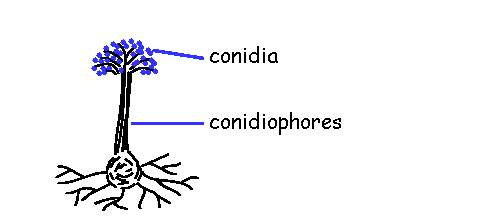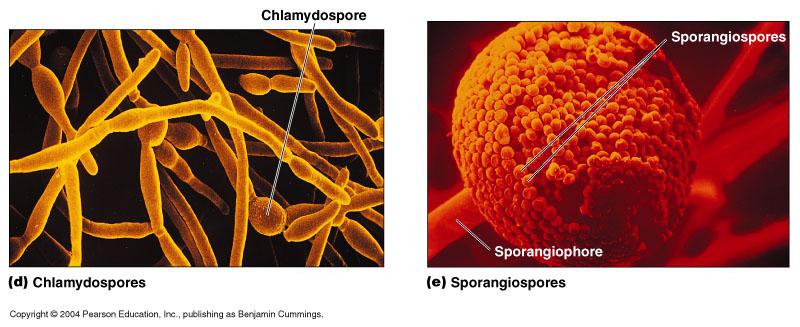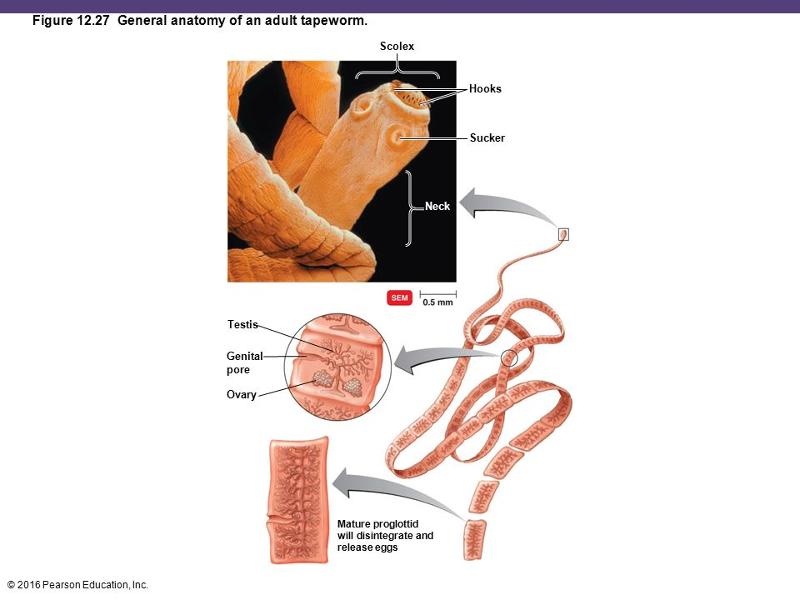Which of the following statements regarding fungi is false
most fungi are pathogenic for humans
Which of the following statements about helminths is false
all are parasites
which of the following pairs is mismatched
coenocytic hyphae - hyphae with cross-walls
which of the following statements regarding protozoa is false
nearly all protozoa causes disease
In mid December, a woman with insulin dependent diabetes which had been in prednisone fell and received an abrasion on the dorsal side of her right hand. She was placed on penicillin. By the end of January, the ulcer had not healed, and she was referred to a plastic surgeon. On January 30, a swab of wound was cultured at 35 degrees on agar. On the same day, a smear was made for gram staining. Slid cultures set up on February 1 and incubated at 25 degrees showed septate hypae and single conidia. The most likely cause of the infection is a
dimorphic fungus
which of the following tends to be more complex in a parasitic helminth than in a free living helminths
reproductive system
Which of the following is false
fungal spores are highly resistant to heat and chemical agents
helminthic diseases are usually transmitted to humans by
gastrointestinal route
All of the following are characteristic of the platyhelminthes except that they
have highly developed digestive and nervous systems
in the malaria parasite life cycle, humans are the ____ host, while mosquitoes are the ___ host as well as the vector
intermediate; definitive
Three weeks after a river rafting trip, three family members experienced symptoms of coughing, fever, and chest pain. During the rafting trip, the family had consumed crayfish that they caught along the river banks. An examination of the patients' sputum revealed helminth eggs, and serum samples were positive for antibodies to Paragonimus. All of the family members recovered following treatment with praziquantel. In the Paragonimus life cycle,
Humans are the definitive host and crayfish are the intermediate host
The encysted larva of the beef tapeworm is called
cysticercus
Which of the following arthropods does not transmit diseases by sucking blood from human host
houseflies
a definitive host harbors which stage of a parasite
adult
what do tapeworms eat
intestinal contents
Giardia and Trichomonas are unusual eukaryotes because they
lack mitochondria
The life cycle of the fish tapeworm is similar to that of the beef tapeworm. Which of the following is the most effective preventive measure?
cooking fish before eating
Which of the following is the most effective control for malaria
eliminate Anopheles mosquitoes
In the microscope, you observe multinucleated amoebid cells with sporangia that form spores. This is a
plasmodial slime mold
Which of the following pairs is mismatched
cestodes - all are free living
which of the following is a nucleated, unicecullar organism that, if you changed the incubation temperature, would form filaments with conidiospores
ascomycete
which of the following organisms is photoautotrophic protozoan
Euglena
if a larva of Echinococcus granulosus is found in humans, humans are the
intermediate host
ringworm is caused by
fungus
yeast infections are caused by
candida albicans
plasmogamy, karyogamy, and meiosis are stages of the fungal sexual life cycle
true
arthropod vectors are blood sucking animals such as ticks, lice and fleas that transmit microbial pathogens
true
cercariae, metacercaria, redia, and sporocysts are all life cycle stages of trematodes
true
the platyhelminths group includes roundworms, tapeworms, and flukes
false
some species of dinoflagellates produce neurotoxins that cause fish kills and red tides.
true
both the cellular slime molds and the plasmodial slime molds are members of the phylum amoebozoa
true
In helminth life cycles, the organism that harbors the adult sexually reproductive phase of the parasite is called the intermediate host.
false
The sporozoite, merozoite, gametocyte, and ring stages are all part of the Plasmodium life cycle.
true
The insect vectors have six legs and include spiders, ticks, mosquitoes, and lice.
false
Most cases of hookworm infection are acquired by ingestion of adult forms in contaminated food or water.
false
Protozoa are unicellular, eukaryotic chemoheterotrophs
true
organisms belonging to apicomplexa are plasmodium and cryptosporidium
true
Parasitic flatworms belong to the Phylum Nematoda and Parasitic roundworms belong to the Phylum Platyhelminthes
false
The adult stage of a parasitic helminth is found in the definitive host
true
The nematodes that infect humans with their larvae include Ancylostoma duodenale and Trichinella spiralis
true
Fungi are aerobic or facultatively anaerobic chemoheterotrophs
true
Zygospores are produced asexually
false
the portion of a hypha that obtains nutrient is called the aerial hypha
false
the cestode, or tapeworm, consists of the scolex and proglottids
true
tapeworms and flukes are similar due to their incomplete digestive system and larval stage
true
protozoan and helminthic diseases are difficult to treat because
their cells are structurally and functionally similar to human cells
Which of the following tends to be more complex in a parasitic helminth than in free living helminths
reproductive system
helminthic diseases are usually transmitted to humans by
gastrointestinal route
which of the following is not a characteristic of parasitic platyhelminths
They have a complete digestive system
cercariae, metacercaria, miracidia, and rediae are stages in the life cycle of
nematodes
the encysted larva of the beef tapeworm is
cysticercus
which of the following arthropods does not transmit diseases by sucking blood from human host
houseflies
what is common between cestodes and trematodes
cuticle
which of the following pairs is mismatched
lice - pneumocystis
which of the following statements is false
fungal spores are resting spores to protect the fungus from adverse environmental conditions
which of the following pair is mismatched
sporangiospore - formed within hyphae
chlamydoconidium - formed in a sac
which of the following is not a characteristic of parasitic platyhelminths
they have a complete digestive system
what do tapeworms eat
intestinal contents
The lifestyle of the fish tapeworm is similar to that of the beef tapeworm.Which of the following is the most effective preventive measure
cooking fish before eating
multinucleated amoebalike cells that produce funguslike spores
plasmodial slime mold
amoebalike vegetatie structures that produce sporangia
cellular slime mold
a multicellular organism; the digestive tract has one opening
tapeworm
an organism that can grow photoautotrophically in the light and chemoheterotrophically in the dark
euglena
the cells of plasmodial slime molds can grow to several centimeters in diameter because
they distribute nutrients by cytoplasmic streaming
ringworm is caused by
ascomycete
why are fungal colonies described as vegetative structures?
because they're composed of the cells involved in catabolism and growth.
what is the thallus
it is the body which consist of long filaments
hyphae
long filaments which contains septa
septa
divides fungi into distinct, uninucleate cell-like units.
conenocytic hyphae
long continuous cells with many nuclei
vegetative hypha
portion of the hypha that obtains nutrient
aerial hyphae
concerned with reproduction
fission yeasts
divides evenly to produce two new cells. parent cell elongates, nucleus divides and 2 offspring cells are produced.
capable of facultative anaerobic growth.
dimorphic fungi
can grow either as mold or yeast
life cycle of fungi
filamentous fungi can reproduce asexually by fragmentation of the hyphae
spores
formation of fungi reproduction, both sexually and asexually
asexual spores
formed by the hyphae of one organism. produced through mitoses and cell division
condiospore
unicellular or multicellular spore that is not enclosed in a sac
conidia/conidiophore

asexual spore
conidia are produced in a chain at the end of conidiophore
sporangiospore/sporangiophore

asexual spore
sporangiospore is formed within a sporangium
sexual spore
results from sexual reproduction
3 stages: phasmogamy, karyogamy, meiosis
phasmogamy
haploid nucleus of donor cells (+) penetrates the cytoplasm of recipient (-)
karyogamy
the (+) and (-) nuclei fuse to form a diploid zygote nucleus
Meiosis
diploid give rise to haploid nuclei
mycosis
fungal infection. it is classified into five groups based on degree of tissue involvement and mode of entry into the host
systemic mycoses
fungal infection deep within the body. It is caused by fungi that live in the soil, it is spread by inhalation
subcutaneous mycoses
fungal infections beneath the skin. It is caused by saprophytic fungi that live in soil and vegetation. Occurs by direct implantation into a wound
cutaneous mycoses
fungi that only infect epidermis, hair, and nails. transmitted by direct contact with infected areas
superficial mycoses
localized along hair shafts and in superficial epidermal cells
opportunistic pathogen
generally harmless in its normal habitat but can become pathogenic in a host who is seriously traumatized.
protozoa
unicellular eukaryotes and inhabits water and soil
mostly aerobic heterotrophs and live in areas with large supply of water
what is the stage of feeding of protozoa called what do they feed upon
trophozoite. They feed upon bacteria and small particle nutrients
life cycle of protozoa
they reproduce asexually by fission, budding or schizogony
what is schizogony
multiple fission. Nucleus undergoes multiple divisions before cell divides
cyst
protective capsule that protozoa produce in adverse conditions.
it permits the organism to survive when food, moisture or oxygen are lacking, temperature are not suitable, or when toxic chemicals are present.
oocyst
cyst formed in members of the phylum apicomplexa.
a reproductive structure in which new cells are produced asexually.
Euglenozoa
2 groups based on rRNA sequences, disk-shaped mitochondria, and absence of sexual reproduction. Euglenoids and hemoflagellates
Amebae
move by extending blunt, lobelike projections of pseudopods
entamoeba histolytica
only pathogenic ameba found in human intestine.
causes dysentery
uses lectin to attache to galactose of plasma membrane and causes cell lysis
aplicomplexa
not motile in their mature forms.
obligate intracellular parasites
sporozoite
an anopheles carrying the infective stage of plasmodium m
merozoites
what is produced when sporozoites undergo schizogony
what is the ring stage
when young trophozoite looks like a ring in which nucleus and cytoplasm are visible.
definitve host
harbors the sexual reproducing stage of plasmodium
intermediate host
host in which the parasite undergoes asexual reproduction
what are the two phyla of helminths
platyhelminths (flatworms)
nematodes (roundworms)
what are some of the characteristics of helminths
they are multicellular eukaryotic animals
they may lack digestive system
their nervous system is reduced
their means of movement is reduced or lacking
reproductive system often complex
larval
developmental stage of parasites
dioecious
male reproductive organs are in one individual while the female reproductive organ is in another
monoecious/hermaphroditic
one animal has both male and female reproductive organs
trematodes (Flukes)
have flat, leaf-shaped bodies with ventral sucker and oral sucker. obtain food by absorbing it thought their cuticle
paragonimus
lung fluke.
occurs through the world
cestodes (Tapeworm)

interstinal parasite.
they lack a digestive system and absorb food through their cuticle
taenia saginata
the beef tapeworm, lives in humans.
taenia solium
pork tapeworm
humans are the only definitive host
echinococcus granulosus
humans are the intermediate hosts
nematodes
roundworms
they have complete digestive system
the males are smaller than the females
ascaris lumbricoides
a large nematode.
it is dioecius with sexual diphormism
define sexual dephormism
the male and female worms look distinctly different, the male being smaller with a curled tail
ancylostoma duodenale
live in the small intestine of humans. eggs are excreted in feces.
how does a larva enter its host
it penetrates the host's skin. it enters the blood or lymph vessel which carries it to the lungs.